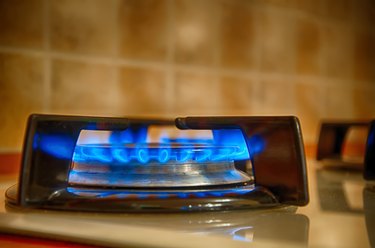Effects of a Gas Leak on Animals
Carbon monoxide is often referred to as the "silent killer" because it is odorless, tasteless, and colorless. Dr. Ingrid Taylor, a veterinarian with 16 years of experience in general clinical and emergency practice and public health, explained that you may not realize you and your pets were exposed to it until it is too late. It can endanger the lives of both the humans in your household and your animal companions. Gas leaks come from household appliances and from operating items indoors that cause a buildup of carbon monoxide. Animals can quickly be overcome due to their small size. Prevention steps as well as rapid action in the event of a leak must be taken to save lives.

Video of the Day
Where carbon monoxide originates
Carbon monoxide leaks can come from anything in the home that uses natural gas or fuels such as propane, charcoal, or wood. This includes stoves, hot water heaters, propane heaters, fireplaces, furnaces, or grills. A dirty chimney can push carbon monoxide back into the home, and using a gas generator, portable camping stove, or charcoal grill indoors also causes a buildup of deadly gas. Even working on a car in the garage with the door open while the engine runs is dangerous.
Video of the Day
Gas companies put a sulfur-like additive in gas so that it can be smelled, but you still can have a gas leak even if you don't smell anything. Sounds ranging from a hiss to a roar near a gas appliance can be a sign of a leak, or you may see damage to connections on a water heater or appliance.
Carbon monoxide poisoning symptoms in animals
More than 400 people die each year from carbon monoxide poisoning, with the young and elderly at the highest risk. The symptoms for humans can resemble the flu at first and move into deeper neurological symptoms, including weakness and disorientation.
Pets are overcome in much the same way, as the gas keeps red blood cells from carrying oxygen throughout the body. Carbon monoxide reduces the oxygen-carrying capacity of red blood cells, which can result in both hypoxemia, which is a low level of oxygen in your blood, and tissue hypoxia, which is insufficient oxygen at the tissue level necessary for homeostasis.
"We are not sure how many pets suffer from carbon monoxide poisoning annually because many cases may not be documented," explains Dr. Taylor. "However, because pets share our homes, they are also at risk of poisoning and can be poisoned in the same way as humans."
Animals can be overtaken by the invisible, odorless gas quickly. Symptoms of carbon monoxide poisoning in animals can present as many different signs. Look for the following symptoms:
- vomiting
- weakness
- dyspnea (difficult or labored breathing)
- coma
- seizures
- acute lung injury
- difficulty breathing
- cardiac arrhythmias
- depression
- deafness
- blindness that can be permanent
- loss of consciousness or possibly death
Birds are more vulnerable and sensitive to the consequences of carbon monoxide exposure than other pets since they have a distinctive respiratory system.
Animals who have recovered from carbon monoxide poisoning should continue to be monitored for a minimum of an additional three to six days and in some cases, even longer. This is because sudden worsening or return of neurological signs can occur as well as delayed neurological effects. Unfortunately, the pet's prognosis could be poor in these cases.

Preventing carbon monoxide poisoning
There are many action steps you can take to detect carbon monoxide in your home as well as to prevent carbon monoxide poisoning. The first step is to make sure there is a battery-operated or battery-backup carbon monoxide detector in your home that will sound an alarm and allow you to safely evacuate. Install the carbon monoxide alarm near your bedroom and check the batteries every six months. Replace the carbon monoxide detector every five years.
Have your chimney inspected or cleaned once a year. Additionally, get your heating system; water heater; and any other oil, coal-burning, or gas appliances serviced by a qualified technician annually. Verify that your gas appliances are properly vented. Do not patch a natural gas leak in a vent pipe with any type of makeshift material, such as tape or gum.
When purchasing gas equipment, only buy equipment with the seal of a national testing agency, like Underwriters Laboratories. If you smell an odor from your gas refrigerator, such as rotten eggs, have a qualified technician service it immediately since it could be an indicator that your fridge is leaking carbon monoxide.
Generators are a source of carbon monoxide. Do not use a generator inside your home or garage. Do not burn charcoal indoors, use a gas oven or range to heat your home, use a portable gas camp stove indoors, or use a portable flameless chemical heater indoors.
Do not run your car or truck inside a garage that is attached to your house even if the garage door is open, as this is unsafe and can be a source of high levels of carbon monoxide. If it is a detached garage, be sure the door is open to allow in fresh air when you run a car or truck inside. Proper ventilation is essential.
Take immediate action to help your pets
If you observe or are affected by signs of carbon monoxide poisoning, your first priority is getting every living creature in the home out into fresh air. If you have several animals to evacuate, open all windows to let in fresh air while you quickly put on leashes or transfer them to travel cages and carriers. For smaller pets in cages, you can grab the cage and go.
Perform CPR if your pet is not breathing. Call an emergency veterinarian if you need to be walked through the procedure. Call 911 if anyone in your home is feeling the effects of the gas. Then, call the gas company to report the leak.
Pet owners should take their pet to a veterinarian or emergency animal hospital right away if they are showing any ill effects or if they were exposed to carbon monoxide. Quick action gives your pet a better shot at recovering from carbon monoxide poisoning. Have the numbers of your regular veterinarian and a 24-hour emergency veterinarian or pet poison control hotline programmed into your cell phone in case you need to get out of your home quickly.
"Carbon monoxide poisoning can lead to severe toxicity to both the nervous system and heart and can have long-term health effects," says Dr. Taylor. "Treatment for your pet consists of oxygen therapy and other supportive care, and your pet may need to be hospitalized and monitored for an extended period of time while recovering."

Observe your pet's behavior
Pay attention if your pet is trying to tell you something with behavior that's out of the ordinary, such as crying or yelping, or if your pet is exhibiting any new symptoms or seems unwell. They may also be insistently trying to lead you somewhere. Pets can sometimes sense that something is off, or they may be feeling sick as a result of carbon monoxide exposure.
If you have sudden, unexplained cases of animals getting sick or dying in your home, investigate the possibility of a gas leak.
The bottom line
Burning fuels produces carbon monoxide, which can lead to carbon monoxide poisoning if it is allowed to build up. When there is too much carbon monoxide in the air, your body's oxygen levels drop because the oxygen in your body is replaced. That can lead to suffocation or other breathing problems and loss of consciousness or even death. If there are signs of poisonous gas in the home, get yourselves and your pets outside to fresh air as quickly as possible.